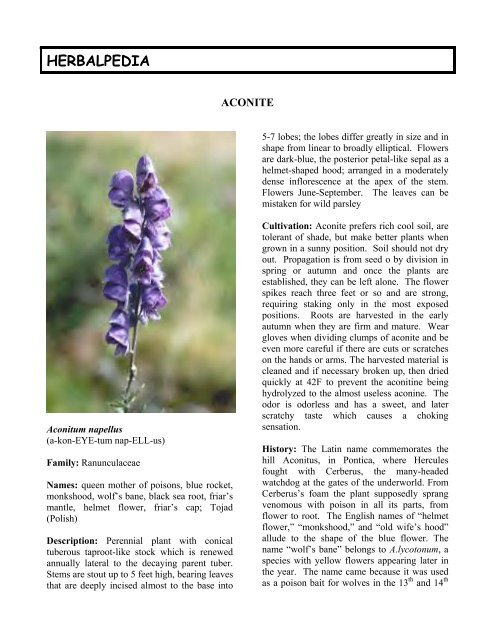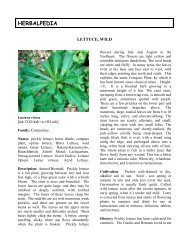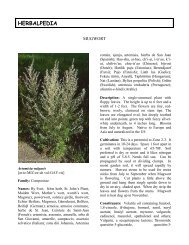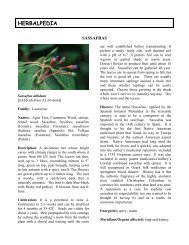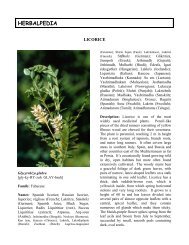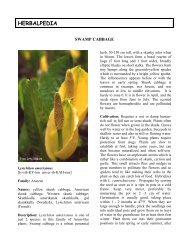Create successful ePaper yourself
Turn your PDF publications into a flip-book with our unique Google optimized e-Paper software.
HERBALPEDIA<br />
ACONITE<br />
5-7 lobes; the lobes differ greatly in size and in<br />
shape from linear to broadly elliptical. Flowers<br />
are dark-blue, the posterior petal-like sepal as a<br />
helmet-shaped hood; arranged in a moderately<br />
dense inflorescence at the apex of the stem.<br />
Flowers June-September. The leaves can be<br />
mistaken for wild parsley<br />
<strong>Aconitum</strong> <strong>napellus</strong><br />
(a-kon-EYE-tum nap-ELL-us)<br />
Family: Ranunculaceae<br />
Names: queen mother of poisons, blue rocket,<br />
monkshood, wolf’s bane, black sea root, friar’s<br />
mantle, helmet flower, friar’s cap; Tojad<br />
(Polish)<br />
Description: Perennial plant with conical<br />
tuberous taproot-like stock which is renewed<br />
annually lateral to the decaying parent tuber.<br />
Stems are stout up to 5 feet high, bearing leaves<br />
that are deeply incised almost to the base into<br />
Cultivation: Aconite prefers rich cool soil, are<br />
tolerant of shade, but make better plants when<br />
grown in a sunny position. Soil should not dry<br />
out. Propagation is from seed o by division in<br />
spring or autumn and once the plants are<br />
established, they can be left alone. The flower<br />
spikes reach three feet or so and are strong,<br />
requiring staking only in the most exposed<br />
positions. Roots are harvested in the early<br />
autumn when they are firm and mature. Wear<br />
gloves when dividing clumps of aconite and be<br />
even more careful if there are cuts or scratches<br />
on the hands or arms. The harvested material is<br />
cleaned and if necessary broken up, then dried<br />
quickly at 42F to prevent the aconitine being<br />
hydrolyzed to the almost useless aconine. The<br />
odor is odorless and has a sweet, and later<br />
scratchy taste which causes a choking<br />
sensation.<br />
History: The Latin name commemorates the<br />
hill Aconitus, in Pontica, where Hercules<br />
fought with Cerberus, the many-headed<br />
watchdog at the gates of the underworld. From<br />
Cerberus’s foam the plant supposedly sprang<br />
venomous with poison in all its parts, from<br />
flower to root. The English names of “helmet<br />
flower,” “monkshood,” and “old wife’s hood”<br />
allude to the shape of the blue flower. The<br />
name “wolf’s bane” belongs to A.lycotonum, a<br />
species with yellow flowers appearing later in<br />
the year. The name came because it was used<br />
as a poison bait for wolves in the 13 th and 14 th
centuries. Herbal history holds that aconite<br />
was used to poison arrows. In Poland it’s<br />
called Slippers of the Blessed Mother.<br />
Aconite’s deadly powers appear to have<br />
been exploited by women. According to one<br />
tale, women could build up an immunity to its<br />
poison by eating minute doses from childhood<br />
and then pass it on to their sexual partners with<br />
lethal results.<br />
Constituents: terpenoid alkaloids (diterpenoid<br />
compounds: aconitine), organic acids (aconitic<br />
acid), starch, sugars, resin<br />
Actions: acts on the central nervous system.<br />
Has a sedative action in certain neuralgias and<br />
in sciatica, febrifuge and is effective in<br />
illnesses of the respiratory trace resulting from<br />
chills; analgesic, antipyretic, local anesthetic<br />
Medicinal Uses: Aconite is poisonous in all<br />
but the smallest doses and is rarely prescribed<br />
for internal use. More commonly , it is applied<br />
to unbroken skin to relieve pain from bruises or<br />
neurological conditions. In Ayurvedic<br />
medicine, aconite is used to treat neuralgia,<br />
asthma, and heart weakness. Aconite has been<br />
added to salves because of its painkilling action<br />
on neuralgia, lumbago, and rheumatism. The<br />
tincture has been given in one-drop doses for<br />
heart failure, high fevers, pneumonia, pleurisy<br />
and tonsillitis. Use only under a professional’s<br />
supervision.<br />
Homeopathic Use: Homeopathic chemists use<br />
the fresh flowering spike, the flowers and the<br />
roots, which yield aconitine, as a febrifuge and<br />
to reduce the pulse rate. Used for sciatica,<br />
neuralgia and chills. It is also used for shock<br />
(especially after surgery or childbirth), chicken<br />
pox, measles, mumps, croup, toothache and<br />
teething.<br />
Toxicity: A deadly poison at the wrong<br />
dosage. Ingestion of even 0.2-0.5 grams of the<br />
root that contains 1% aconitine may cause<br />
death to an adult.<br />
Ritual Uses: Properties: funereal herbe, herbe<br />
of consecration, herbe of immortality, herbe of<br />
protection, visionary herbe. Aconite is one of<br />
the herbes used in traditional 20 th witchcraft to<br />
consecrate the ritual knife. Its primary<br />
magickal use is in the consecration of magickal<br />
blades. An infusion provides the practitioner<br />
with a magickal wash and may be used with<br />
any ritual tool or sacred space. One of the<br />
herbes believed part of the legendary flying<br />
ointment, the symptoms of poisoning by<br />
aconite could lead the practitioner to<br />
experience sensations similar to flying.<br />
Aconite may be integrated into rituals of death<br />
and dying in a variety of ways ranging from<br />
tossing it into the fire, using it to aspurge the<br />
Circle, or through memorial plantings.<br />
Spiritual Properties: Aconite may be carried<br />
as a talisman to maximize potential and<br />
overcome indifference and apathy. It will<br />
stimulate the fire within and help one to move<br />
out of fixed conditions. Medicinally, it offers<br />
freedom from suffering through its treatment of<br />
feverish pain and its use as a heart anodyne.<br />
The nature of aconite’s freedom is that of<br />
unconventional or nonordinary reality.<br />
Resources:<br />
Companion Plants, www.companionplants.com<br />
plants<br />
Crimson Sage, http://www.crimson-sage.com<br />
Plants<br />
Richters, www.richters.com seeds, plants<br />
References:<br />
A Compendium of Herbal Magick, Paul<br />
Beyerl, Phoenix Publishing, 1998; ISBN: 0-<br />
919345-45-X<br />
Medicine Grove, Loren Cruden, Destiny<br />
Books, 1997; ISBN: 0-89281-647-3<br />
The Spirit of Herbs, Michael Tierrra and<br />
Candis Cantin, 1993, US Games; ISBN: 0-<br />
88079-525-5<br />
HERBALPEDIA is brought to you by The Herb Growing &<br />
Marketing Network, PO Box 245, Silver Spring, PA 17575-0245; 717-<br />
393-3295; FAX: 717-393-9261; email: herbworld@aol.com URL:<br />
http://www.herbalpedia.com Editor: Maureen Rogers. Copyright 2006.<br />
All rights reserved. Material herein is derived from journals,<br />
textbooks, etc. THGMN cannot be held responsible for the validity of<br />
the information contained in any reference noted herein, for the misuse
of information or any adverse effects by use of any stated material<br />
presented.


